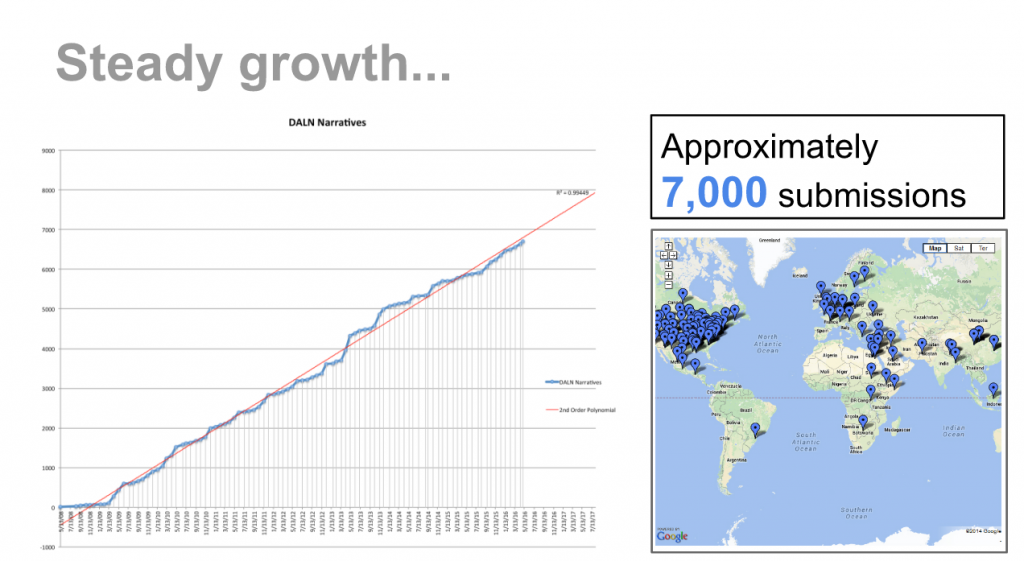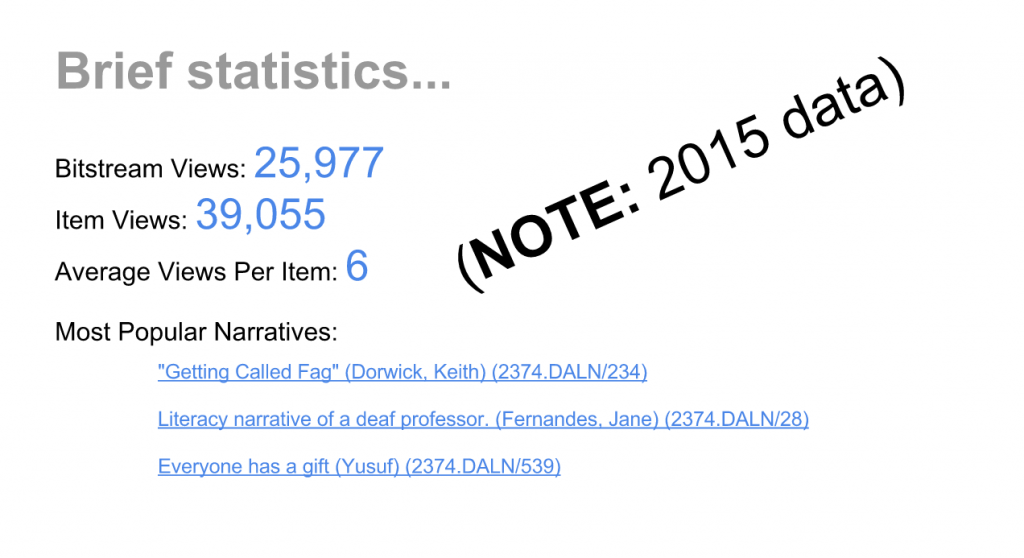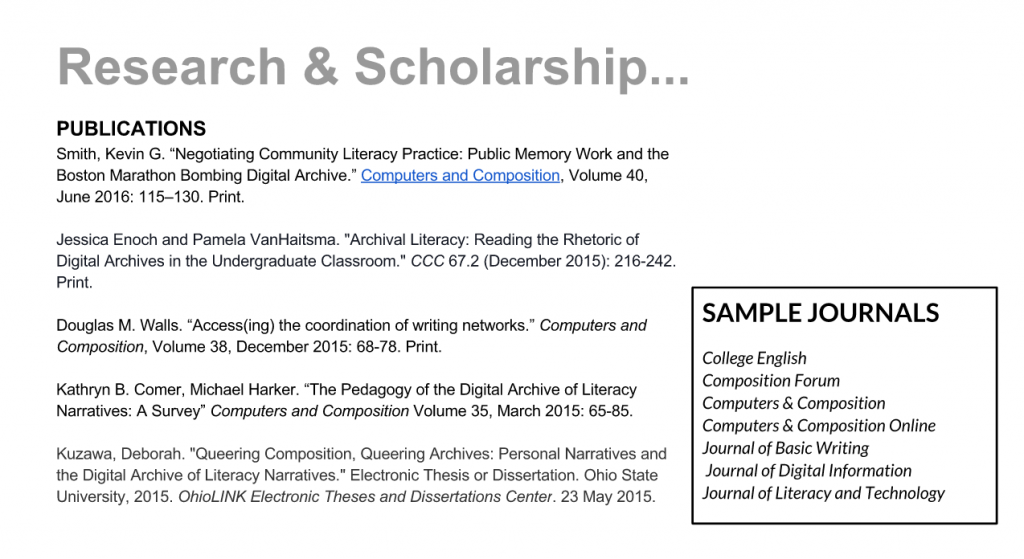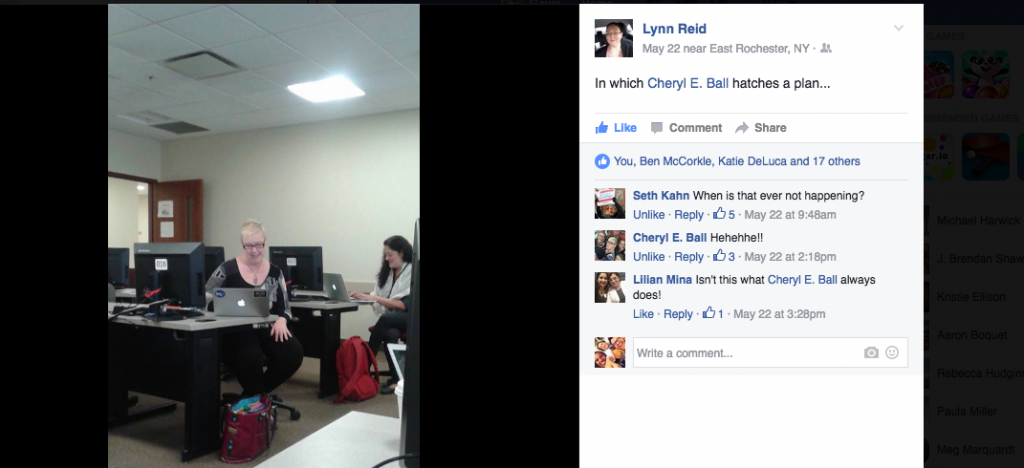Presenter
Ben McCorkle, The Ohio State University at Marion
Review
It is pretty difficult to wake up for 8:30 AM Sunday sessions. It is even more difficult to wake up for 8:30 AM Sunday sessions following an evening wishing Cindy and Dickie Selfe a happy retirement in a crowded hotel suite with Cindy’s (in)famous margaritas. It is still more difficult to wake up for 8:30 AM Sunday sessions when the coffee supply has been secretly moved from the registration area and a gaggle of scholars are in search for caffeine. Nevertheless, 8:30 AM Sunday sessions are important and are often spaces where exciting plans for the upcoming year are hatched.

Take for example, the DALN Organizational Meeting (#i4 #cwcon). This particular 8:30 AM Sunday session opened with Ben McCorkle firmly asserting, “The State of the DALN is Strong!” McCorkle’s statement comes at transitional moment for the Digital Archive of Literacy Narratives (DALN). Founding co-director Cindy Selfe’s retirement, an upcoming upgrade to the hosting partner, and the new co-directorship of Ben McCorkle and Michael Harker (Georgia State University) means big changes are coming to the DALN in the upcoming years.

After briefly recalling the origins of the DALN, which was co-founded by H. Lewis Ulman and Cindy Selfe and began collecting narratives in 2008, McCorkle demonstrated the steady growth of the DALN’s collection (see image 2). At nearly 7,000 individual submissions, the DALN has consistently archived approximately 1,000 narratives per year since it’s inception. The bulk of these narratives are collected at professional conferences such as the Conference on College Composition and Communication (4Cs) and the Rhetorical Society of America Conference (RSA), through special undergraduate and graduate courses focused on literacy (e.g. OSU’s Literacy Narratives of Black Columbus course), and random submissions from interested participants. As an open-access archive, the DALN is able to host submissions from across the globe. McCorkle also provided a few brief statistics on the average views per item and the most popular narratives in the collection (see image 3).

Moving forward, McCorkle discussed the previous year’s news, and focused on a few logistical issues such as the OSU Library renewing its support and GSU’s Tech Incubator considering ways to start revising the DALN’s interface. The first steps in this revision, McCorkle noted, will include streaming capabilities for digital multimedia narratives and an update to the hosting partner. McCorkle explained that one of the reasons they have been slow to redesign the DALN’s interface has to do with an attempt to keep the submission process open and easy for non-OSU participants. Certain updates to the system would require additional layers of data input from participants, and the DALN staff is trying to think of ways of keeping the submission process simple.
The move towards revision, McCorkle noted, comes with an impressive year of news coverage (NPR, Arts ATL, and OSU and GSU press), grant partnerships with CCC Committee on Undergraduate Research and See Your Speech, and a growing list of academic publications using the DALN as a research tool. The point about the DALN being used as a research tool is particularly impressive considering that the original mission of the DALN was one of preservation, protection, and access of/to literacy narratives, not necessarily research. Therefore, that the qualitative research based on the DALN’s collections has been the source of dissertation research and accepted to leading journals in the field such as College English, Computers & Composition, and College Composition and Communication (CCC) is quite an accomplishment (see image 4). Looking forward, Harker, Comer, and McCorkle’s collection The Archive as Classroom: Pedagogical Approaches to the DALN, which McCorkle describes as a sequel to Ulman, DeWitt, and Selfe’s Stories that Speak to Us, is underway with chapter drafts currently under review.

The final portion of McCorkle’s formal presentation was a “check in” with Michael Harker, who was not able to attend the conference. Harker’s news celebrated the submission of President Jimmy Carter’s literacy narrative as the 6000th submission, the launch of the DALN Blog, the development of a DALN mobile site, and new recruitment plans for upcoming conferences. McCorkle expanded on these items by noting that the DALN Blog is a user-friendly site that provides teaching resources for those wanting to incorporate the DALN into their classrooms and features guest blogs from teachers and scholars who have used the DALN in class and in research. Additionally, the DALN mobile site, when launched, will allow users to upload, tag, and archive narratives directly from their mobile devices, and #4C17 goers can expect to receive “I Gave Mine” stickers after providing narratives—think the “I Voted” stickers you’ll proudly wear in November. Finally, Hawker and McCorkle teased additionally “high profile” narratives coming in the next year.
Following the formal presentation, McCorkle opened the floor to discussion. Of the small group gathered (me, Lynn Reid, Jason Palmeri, and a few others), we discussed the ways we have used the DALN in our classrooms. One suggestion was to use the narratives as models for students composing their own literacy narratives. Building from that point, we discussed the use of “translation assignments” (to borrow an idea from Palmeri’s Remixing Composition) that would have students translate a literacy narrative in one mode to another (alphabetic to audio or audio to alphabetic) while demonstrating critical literacy and storytelling skills. Another point was to have students explore the archives to gain an understanding of the vastness of the term literacy and the multiple ways it occurs and reoccurs throughout culture. Noting my own research, I suggested using the DALN to curate a small exhibit of narratives which helps to demonstrate a specific analytical lens while also teaching students about important themes like social justice, Black Queer literacies, and the ethics of ethnographic research.
As the session made its way towards a conclusion, Cheryl Ball joined us. Ball reignited the conversation by suggesting that the DALN join a group she was launching that would act as a support network for editors of journals focused on publishing digital, multimodal scholarship (see image 5). The room began to discuss some of the issues concerning digital publishing and brainstormed ways of building this network. The room felt electric. People where making suggestions, finding email addresses, laughing at the absurdity of the coffee being moved away from the main registration area. The excitement in the air, the possibilities awaiting the DALN and its participants, and a brief look at the state of digital publishing were all worth waking up for an 8:30 AM Sunday session.

Images:
Images 1, 2, 3, 4: taken from Ben McCorkle’s presentation slides with permission
Image 5: taken from Lynn Reid’s Fb profile with permission from Reid.
Embedded Links:
Digital Archive of Literacy Narratives: http://daln.osu.edu/
Literacy Narratives of Black Columbus: http://blackcolumbus.osu.edu/theProject/default
NPR story “GSU Archives Tales of Literacy, One Story At A Time”: http://news.wabe.org/post/gsu-archives-tales-literacy-one-story-time
Stories That Speak to Us: http://ccdigitalpress.org/stories/
Jimmy Carter’s Literacy Narrative: http://daln.osu.edu/handle/2374.DALN/5901
DALN Blog: https://thedaln.wordpress.com/
